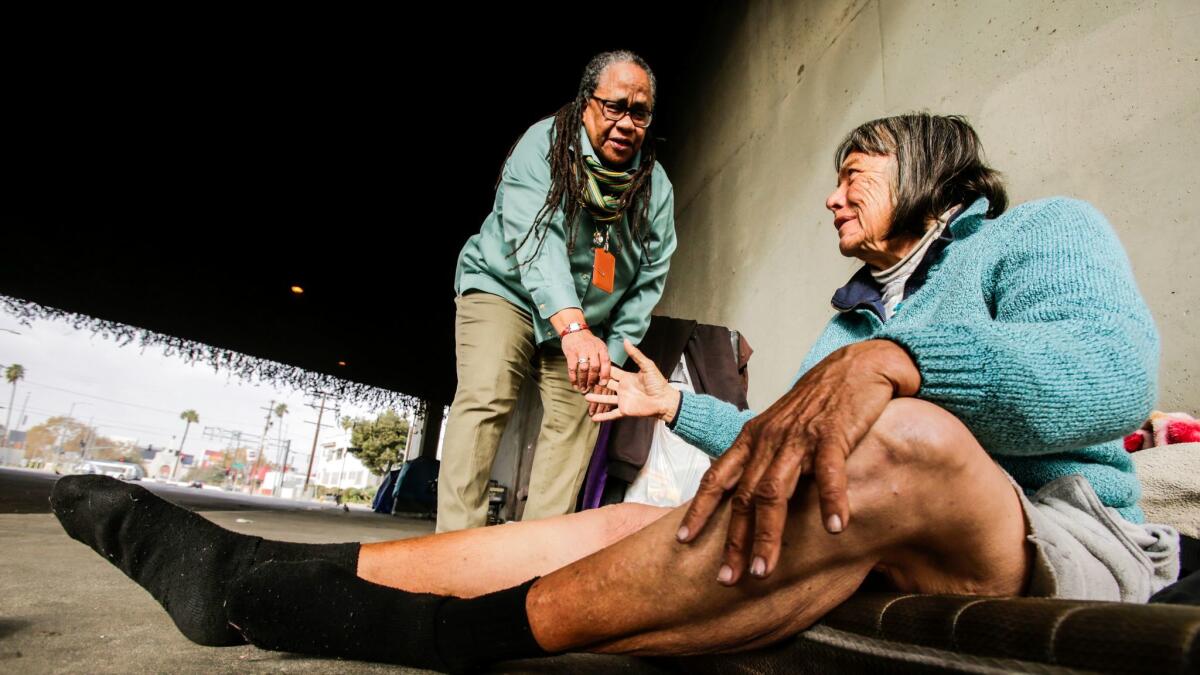With so little housing for the homeless, can outreach workers really help?

- Share via
For homeless people adrift on the streets or moored temporarily in a shelter bed, an outreach worker can be the lifeline to everything from a bottle of water to a permanent supportive housing unit. At a time when passersby routinely ignore homeless people, outreach workers are the ones who do talk to homeless people on the street, returning numerous times to win their trust, get them services and steer them toward housing. It’s slow, painstaking work, but it’s essential to getting people off the streets.
But how many people is it getting off the streets? Not a lot of them, according to a performance audit of the Los Angeles Homeless Services Authority. The audit, conducted by Los Angeles City Controller Ron Galperin, said the agency fell significantly short of its modest goals to get people living in encampments into housing or services. The audit looked only at the work that LAHSA did on a special contract with the city to focus on street encampments there.
Out of 6,634 people contacted by outreach workers this past fiscal year, LAHSA workers “engaged” (or began working with) 4,199. The goal was to place 20% of the people engaged by workers into short-term housing or shelter. Instead, the agency placed 14%. Similarly, the goal was to put 10% into permanent housing, but only 4% went into housing. The agency also hoped to put 25% of the people who said they had a mental illness into mental health services. Instead, 4% sought services — that the agency knows of.
It’s troubling that LAHSA could not scale even these low bars that it set for itself. The city and LAHSA need to revamp their goals and how they get measured and then expect them to be met. One big problem that both the city auditor and LAHSA noted was that most of the outreach was reactive. LAHSA workers are obligated to show up at an encampment before a Bureau of Sanitation cleanup, and sometimes they get that call at the last minute, according to LAHSA officials. Having a phalanx of sanitation workers and police officers standing by, waiting to dismantle tents, isn’t the ideal backdrop for outreach work.
LAHSA officials say that they are already doing more proactive outreach at encampments in the city. That’s smart. But the bigger issue here is what should be the goal of outreach overall? LAHSA‘s outreach work and management of homeless services span the entire county. The grim reality is that no matter how many of LAHSA’s 851 outreach workers fan out across the area, they cannot offer all or even most of the county’s nearly 59,000 homeless people permanent housing or a shelter bed. There just isn’t enough housing to go around. If being an outreach worker is a job that depends entirely on whether you can get a homeless person to trust you, telling someone that you’re putting him or her on a mythical waiting list for housing is the worst kind of betrayal.
In some ways, though, with the housing supply so uncertain, outreach is more critical than ever. Outreach can also be intervention — helping people on the street gain access to such essentials as trash cans, a mobile shower and toiletries. It can mean helping people rebuild lives — taking them to a medical appointment or the Department of Motor Vehicles for a new I.D. or helping them sign up for welfare. And people still need to be convinced by outreach workers to answer the lengthy set of questions at the front end of the Coordinated Entry System, which homeless people go through to get housing or services from LAHSA or publicly funded agencies. The system determines who gets priority for whatever housing does become available.
LAHSA officials say they are already emphasizing these kinds of outreach efforts and analyzing how well they are going, as opposed to measuring only how many people get placed into housing. They also should get a better handle on available shelter beds. Scarce as they are, they do turn over, and LAHSA needs to fast-track an app it has been working on to provide outreach workers with real-time information about the availability of shelter beds. Part of the problem is getting shelter operators to provide up-to-date information. Why not pay them to do so?
As LAHSA’s chief program officer, Heidi Marston, said, “Housing will always be the North Star.” And it should be the ultimate goal. But, in the meantime, outreach workers have to do a better job getting homeless people the services that are available now.
More to Read
A cure for the common opinion
Get thought-provoking perspectives with our weekly newsletter.
You may occasionally receive promotional content from the Los Angeles Times.









